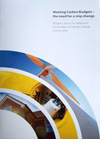
“This is a story of betrayal, a story of selfishness, greed, and irresponsibility on an epic scale.” That’s how James Hoggan opens his newly published book Climate Cover-Up: The Crusade to Deny Global Warming. Hoggan initially thought there was a fierce scientific controversy about climate change. Sensibly he did a lot of reading, only to find to his surprise that there was no such controversy. How did the public confusion arise? There was nothing accidental about it. As a public relations specialist, Hoggan observed with gathering horror a campaign at work.
“To a trained eye the unsavoury public relations tactics and techniques and the strategic media manipulation became obvious. The more I thought about it, the more deeply offended I became.”
DeSmogBlog was born to research the misinformation campaigns and share the information widely. This book pulls together some of that research in an organised narrative. Richard Littlemore has assisted Hoggan in the writing.
Climate scientists are sometimes blamed for not communicating their message clearly enough to the public. If they tried to match the efforts of the denial campaigners as detailed by Hoggan they wouldn’t have any time to do their science. Those who vociferously claim that anthropogenic global warming is still uncertain and doubtful certainly don’t spend time and money on any science. That is not what they are interested in. As far back as 1991 a group of coal-related organisations set out, in their own words, “to reposition global warming as a theory (not fact)” and “supply alternative facts to support the suggestion that global warming will be good.” This was the pattern of the work done in succeeding years by a variety of corporations and industry associations who devoted considerable financial resources to influence the public conversation. They used slogans and messages they had tested for effectiveness but not accuracy. They hired scientists prepared to say in public things they could not get printed in the peer-reviewed scientific press. They took advantage of mainstream journalists’ interest in featuring contrarian and controversial science stories. They planned “grassroots” groups to give the impression that they were not an industry-driven lobby. New Zealand’s Climate “Science” Coalition and the International Coalition it helped to found fit this purpose nicely.
Hoggan describes the work of many individuals and organisations who are available for spreading the doctrine of doubt. Conservative think tanks such as the Competitive Enterprise Institute (CEI) have played a major part in the task in the new millenium. Their donors are well disguised, but in the case of CEI have certainly in the past included ExxonMobil and probably GM and Ford. Their advocacy, such as the infamous TV commercials portraying the benefits of carbon dioxide, obviously involves heavy expenditure.
Lists of scientists reportedly expressing dissent over anthropogenic global warming have become a staple of the denial crusade. Hoggan discusses some of these lists and comments:
“The beauty of this tactic as a method of keeping the debate alive is that none of these ‘scientists’ ever have to conduct any actual research or put their views forward to be tested in the scientific peer-review process. They don’t even have to be experts in a related field. And they certainly don’t have to win the argument. As long as groups of scientists are seen to be disagreeing, the public continues to assume that the science is uncertain.”
Apparent throughout Hoggan’s book is the lack of substance to the denial campaign. According to them, the Mann hockey stick is a “notorious intellectual swindle”. The impression is sedulously fostered that statistical investigation has shown the graph to be false. But Hoggan points out that the ideologists are uncurious about whether Mann’s work has been tested by other scientists or confirmed or falsified by the use of other methods or other proxy data sources. He dryly comments that the reason is that the other climate-reconstruction graphs published since Mann produce enough hockey sticks to outfit a whole team and then some.
A significant movement in the campaign in more recent times has been a change of emphasis from denial that anthropogenic warming is occurring to claims that there is no need to rush into measures to mitigate it. Bjorn Lomborg argues with apparent passion that he also cares about climate change, but that careful economic analysis shows that more pressing problems like AIDS, malnutrition, and the provision of fresh water to people in the developing world are more important matters and unfortunately don’t at this stage leave enough money for climate change mitigation. Frank Maisano specialises in media communication. He supplies thousands of reporters and important people in industry and politics with useful material on energy issues. Underlying it though is a consistent argument that climate change, though real, is either impossible or too expensive to fix.
In his chapter on the manipulated media Hoggan acknowledges the complexity issue in relation to global warming. Indeed he extends a lot of understanding to reporters and editors. They are under pressure and the science takes some understanding. The temptation to fall back on balance has been strong. However he notices that increasingly the balance model is being abandoned, and is insistent that it’s past time for people in the media to check their facts and start sharing them ethically and responsibly with the public.
Hoggard’s book is a thoughtful and sustained exposure of a movement which has done great harm. I read it with close interest and shared his dismay. I recommend it to anyone who wants to understand how denial has had such a charmed run. His presentation is painstaking and reasonable. There’s nothing shrill about it, and his justifiable anger is relatively muted. He urges his readers not to take him at face value but to do some checking of his material and satisfy themselves that it is reliable. Nevertheless the activity he describes is rightly characterised as betrayal, selfishness, greed and irresponsibility. The people who have launched the highly successful campaign of denial and delay are not attending to the work of a body of outstanding scientists although that work is of utmost import for human life. They have turned what should have been a public policy dialogue driven by science into a theatre for a cynical public relations exercise of the most dishonest kind. Instead of looking at the seriousness of the warnings they have sensed a threat to their business profitability and made that their motivating factor. They have spread a false complacency and the result has been a twenty year delay in addressing an issue of high urgency.
Hoggard thought at first that David Suzuki was a bit over the top when he wondered out loud whether there was a legal way of throwing Canada’s so-called leaders into jail for criminal action (or inaction) in relation to climate change. But then he recognised Suzuki was right, in the sense that it will indeed be a crime if we do not demand of our leaders that they start fixing this problem, beginning today.
“And the punishment will be visited on our children and on their children through a world that is unrecognisable, perhaps uninhabitable.”
Like this:
Like Loading...

 According to the Rotorua Daily Post, Garth George is “a veteran newspaperman living semi-retired in Rotorua”. Garth sallies forth from time to time to lend the benefit of his wisdom on climate policy to the readers of the NZ Herald, and on Thursday Oct 8th offered the
According to the Rotorua Daily Post, Garth George is “a veteran newspaperman living semi-retired in Rotorua”. Garth sallies forth from time to time to lend the benefit of his wisdom on climate policy to the readers of the NZ Herald, and on Thursday Oct 8th offered the 
 The UK’s
The UK’s